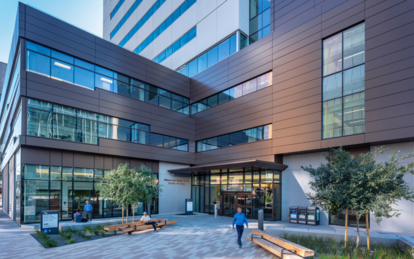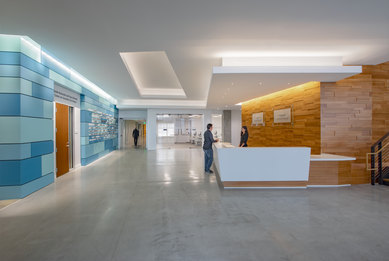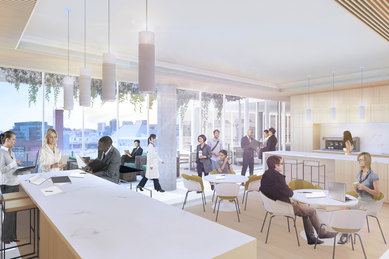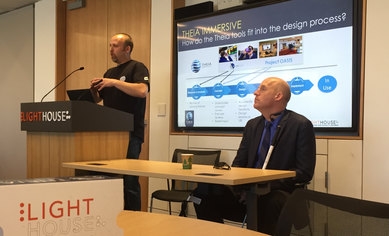Engaging Clinicians and Researchers To Craft Innovative Research Spaces

Form follows feedback. In the complex world of academic research design, deep collaboration and engagement with multi-user and multi-stakeholder groups is vital to deliver the types of spaces to advance research and improve the patient experience.
Two recent projects at the UCSF Mission Bay campus evince SmithGroup teams’ ability to immerse themselves in the complex details of the neurosciences and vision care. The University’s core mission and values of PRIDE (Professionalism, Respect, Integrity, Diversity and Excellence) inspired the teams’ approach and solutions. The Wayne and Gladys Valley Center for Vision and the Joan and Sanford I. Weill Neurosciences Building were designed and constructed with the goals of facilitating research and improving patient experiences and outcomes.
Before a single sketch was made, the Valley Center for Vision team engaged a parallel set of stakeholders and embarked on a consensus-building process that transcended institutional boundaries. The planning team engaged in a multi-day on-site observation of the ophthalmology practice, tracing patient and provider patterns. Meetings with each specialty and subspecialty followed to better understand issues and possibilities. Concurrently, the team immersed itself in understanding the unique perspectives of patients visiting the clinics. The plans were converted to braille and Chris Downey, a blind architect based in San Francisco, provided input. At Chris’ suggestion, the SmithGroup team toured The LightHouse, a center for visually impaired individuals and imagined ways, through the use of space, color, materials and detailing, that the patient experience could be improved.
When protocols and aspirations were fully understood, the design team tackled the optimal exam room—comfortable for patients and ergonomically correct and with the least amount of nonproductive movement for practitioners. In collaboration with design-build partner Webcor, SmithGroup constructed a full-size exam room mockup for caregivers to test and evaluate. It was fine-tuned until the correct positioning of all elements was achieved. Other features of the interior design were responsive to the visually impaired, from discernable approaches such as the use of vivid color for the partially sighted to more subtle details like the use of varied flooring materials to assist with auditory cues.

Saturated color and cues integrated into the design assist all users with wayfinding.
The Joan and Sanford I. Weill Neurosciences Building is designed as a beacon for the UCSF Mission Bay campus, its form conceived by the San Francisco firm Mark Cavagnero Associates as design architect in collaboration with SmithGroup as executive architect. It is intended to be transparent, daylit and inviting, while also protecting patient privacy.
The Weill Neurosciences Building brings together psychiatry and other neurosciences research with clinical and support spaces to drive advances aimed at holistic treatment of disorders of the brain and nervous system. For the first time, the full patient experience is brought together under the same roof as research, diagnosis and treatment. As with the Valley Center for Vision, user and stakeholder groups were not only brought into the mix but educated to better understand the design process and why their participation was integral to the final design.
An inspirational series of “lunch and learns” was initiated by UCSF clinicians and researchers to enlighten the design and construction team on the kind of work that will be completed in the building. This made the team part of something larger than themselves—demonstrating that the Weill Neurosciences Building was a partnership for the betterment of humanity.
At the base of the design and construction endeavor was a sophisticated Integrated Project Delivery (IPD) method. Our team folded the user and stakeholder engagement process into the overall project schedule so that the broader integrated project team could see the timeline and its critical role in the decision-making process. Colocation in a Big Room setting ensured designers and users/stakeholders were in the same room when critical decisions were being made.
All available means were used to communicate design to users and stakeholders. These included sketches, spreadsheets, 2D drawings and eventually 3D fly-throughs and virtual reality to provide detailed immersive views of the finished building.

Town Centers are located throughout the Weill Neurosciences Building to encourage casual interactions between research and clinical staff
As for the patient experience at the Weill Neurosciences Building, “equal access” and “no stigma” were the philosophies of the client and design team. The translucent profile of the building is a metaphor for giving neurosciences and psychiatric patients—so long relegated to the “back door” and held out of sight—the dignity they deserve. In much the same way, egalitarianism and goodwill informed the clinician and researcher space. “Town Center” social and eating hubs are designed to bring all building occupants out of their research, patient care and comfort zones for vibrant and useful fellowship. Spontaneous encounters at all caregiver levels can lead to amazing collaborative opportunities when many intelligent and dedicated people work under the same roof.
If real estate is all about “location, location, location” then architecture is all about “people, people, people.” The Valley Center for Vision and Weill Neuroscience Buildings are humanist-centered architecture at its finest. They were designed with the advice and consent of the users and stakeholders and carefully crafted to support important neurosciences and vision research advances while providing serenity and comfort to patients and their families.



